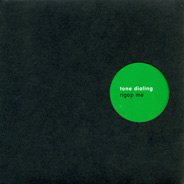Tone Dialing
Rigop Me
(Evil Rabbit Records)
It
still happens, if only once in a while, that I get to be pleasantly surprised
by a CD that I've found in my mailbox: a "mysterious object",
recorded by an "unknown entity" (at least, unknown to me), that
after the proper number of listening sessions reveals itself to be, if
not an unprecedented masterpiece (I'm very sorry to say this, but for a
long series of reasons, our present time is not the most favourable era
when it comes to producing masterpieces), at least something that reveals
a skillful use of form, and the chosen technical means.
This
is the case with Rigop Me, an album that (according to the liner notes)
is for the most part derived from live improvisations, with no overdubs
(but I believe the work, which was recorded by Colin McLean at OT301 in
Amsterdam, and mastered by Erst Karel, to have been mixed and edited later).
Tone Dialing is the name of a trio of musicians performing here, whose
degree of mutual understanding (though "open", the musical line
is never vague, or uncertain) tells of a long mutual past knowledge.
The
line-up consists of Jorrit Dijkstra on lyricon, analog synthesizer, and
loop machine; Paul Pallesen on (electric) guitar, and analog electronics;
Steve Heather on drums, percussion, and sampler. It's a trio whose sound,
taken as a whole, has a pleasant "electronic" flavour, with a
somewhat
"lo-tech" (if not "lo-fi") trait that reminded me of
Zga's
"naïveté" (though this trio don't resemble Zga at all). Here,
"at first sight", coordinates appear to be at about halfway between
some "particles"-friendly approaches to modern improvisation that
put sound under a microscope, and some trends ("illbient"?
"intelligent techno"? "slow techno"?) that have the sound
develop well inside a rhythm map.
Seeing
the name "lyricon" made me fear for the worst: an old, almost
home-made, instrument designed in order to give wind instruments the modern
potential of synthesis (at a later stage than the Steinerphone, but well
before Yamaha's industrial approaches), the lyricon reminds me most of
all of Tom Scott's so-so explorations. Here the opposite is true: the instrument's
sound is not clichéd, its timbres not so easily "recognizable".
I have to add that - I did a Web search after assimilating the CD - Jorrit
Dijkstra's background and projects (maybe he's not the leader, but here
he's a first among equal) appeared to be quite different from what I had
imagined; hence, maybe, a reason why this project is so strong.
At
ten minutes, Gumyt Me is a very "user-friendly" opening track:
regular rhythmic loops that repeat themselves at intervals that are quite
apparent to one's ear, long events over a rhythmic figure, everything clearly
placed on the time grid; snare drum played with brushes, a trebly guitar,
interesting timbres, a closing rimshot.
For
brevity's sake I will define the following track, Fezex Me, as a timbrally
more varied and interesting, but totally free from an apparent pulse, version
of the previous track. There's an "orchestral" crescendo at about
2' 50", with low-sounding percussion sounding almost like tympani,
and two highly dramatic events - frequencies shifting abruptly - at about
5' 24"
and 7' 07".
Rigop
Me is a composed track, with a slow unison lyricon-guitar which almost
works as a theme, with percussion in the background; all becoming faster,
almost double-time, the guitar now playing chords; here the lyricon performs
a melodic line whose sound changes, from that of a harp to the peculiar,
bell-like sound of something going through a ring modulator. "Dramatic" drums
enter at 5' 30", in closing we have a brief loop (almost like a LFO
cycle).
Overtly
rhythmic, trebly cymbals, a bass drum that bit by bit comes to the foreground,
with a "medium" groove, Yoxia Me reminded me more than a bit
of Can: at first, of Can in their Soon Over Babaluma period, then - when
the lyricon started sounding like an "ethnic flute" - of Can
in some of their Ethnological Forgery Series episodes; there's a strange
guitar, sounding at first almost like a mutation of those "sliding" chords
played by classic-era Steve Cropper, then sporting some funky accents!
Oemik
Me works quite well in opposition to the previous track: not as rhythmically
pushed, it's timbrally quite varied, with a very expressive low-end frequency,
and a nasal timbre so typical of the square wave that, near the end, unexpectedly
gives shape to a rhythmic figure.
Closing
the CD, another composed track: the brief Ziyak Me has a nice synthetic
part which almost works as a tuba part, trebly cymbals, and some slow guitar
arpeggios; a nice melody played on the lyricon is in the background, then
the guitar is playing almost like a mandolin, then more cymbals and drums;
surprisingly, the final result reminded me of something quite on the Pastoral
(!) side.
Beppe Colli
© Beppe Colli 2008
CloudsandClocks.net | June 4, 2008











